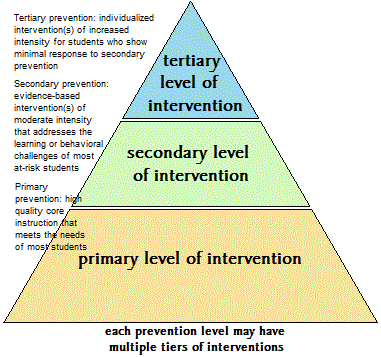|
IDEA 2004 states that a specific learning disability diagnosis may be determined in part by how a child responds to a scientific, research-based intervention: this approach to diagnosis is referred to as response to intervention (RTI). It integrates assessment and intervention within a multi-level prevention system. The RTI process looks at students in the general education population who are given standard instruction and monitors their progress. Students making poor progress are provided evidence-based interventions including specialized instruction. Their progress is continuously monitored and interventions adjusted to maximize improved learning outcomes. When RTI is being used from the very earliest grades, prevention is the ideal.
4 Essential Components to RTI
* A school-wide, multi-level instructional and behavioral system for preventing school failure;
* Screening;
* Progress Monitoring; and
* Data-based decision making for instruction, movement within the multi-level system, and disability identification
Identification/Screening Process
Screening is an assessment procedure characterized by brief, efficient, repeatable testing of age-appropriate academic skills (e.g., identifying letters of the alphabet or reading a list of high frequency words) or behaviors. Screenings are conducted for the purposes of initially identifying students who are “at-risk” for academic failure and who may require closer monitoring and/or further assessment.
RTI uses a 2-stage screening process.
Stage One: Universal screening, is a brief assessment for all students conducted at the beginning of the school year; however, some schools and districts use it 2-3 times throughout the school year. For students who score below the cut point on the universal screen.
Stage Two: a second stage of screening is then conducted to more accurately predict which students are truly at risk for poor learning outcomes. This second stage involves additional, more in-depth testing or short-term progress
monitoring to confirm a student's at risk status. Screening tools must be reliable, valid, and demonstrate diagnostic accuracy for predicting which students will develop learning or behavioral difficulties.
* Screenings of all students should be conducted three times per academic year (fall, winter, spring) to help ensure the early identification of students potentially at risk and the areas in which they may experience difficulty.
* Screening instruments should be valid and reliable and aligned with grade-level curriculum based on learning standards.
Intervention Process
RTI is a delivered to students in tiers or levels. There is much discussion about how many tiers should be in RTI models. The three-tiered model is the most common. This means there are different levels of intervention, based on the needs of the student. The level of intervention increases in intensity if a child does not respond to instruction.

*note:
Students can and should move back and forth across levels of intervention based on their success. Students can also recieve support in different levels for different acedemic needs.
Primary Intervention Includes
Primary intervention offers a core curriculum that is research-based. Teachers use instructional practices that are culturally and linguistically responsive. To determine need, universal screening is used and assesses students’ current level of performance. Interventions can include differentiated learning activities (e.g., mixed instructional grouping, use of learning centers, peer tutoring) to address individual needs and accommodations to ensure all students have access to the instructional program. Progress in constantly monitored to identify and modify interventions, as needed, to address behavior problems that prevent students from demonstrating the academic skills they possess.
Secondary Intervention Includes
Secondary prevention has at least three distinguishing characteristics:
o it is evidence-based (rather than research-based);
o it relies entirely on adult-led small-group instruction rather than whole-class instruction;
o it involves a clearly articulated, validated intervention, which should be adhered to with fidelity.
Secondary prevention is expected to benefit a large majority of students who do not respond to effective primary prevention. As evidenced by progress monitoring data, students who do not benefit from the interventions provided under secondary prevention may need more intensive instruction or an individualized form of intervention, which can be provided at the tertiary prevention level.
Tirtiary Intervention Includes
Tertiary prevention, the third level of the RTI prevention framework, is the most intensive of the three levels and is individualized to target each student's area(s) of need. At the tertiary level, the teacher begins with a more intensive version of the intervention program used in secondary prevention (e.g., longer sessions, smaller group size, more frequent sessions). By watching the students progress, improvement, or lack thereof, can be detected over time. When data suggests slow or non-existent progress the teacher modifies parts of the intervention program and continues to monitor the student to evaluate which components enhance the rate of student learning. By continually monitoring and modifying (as needed) each student's program, the teacher is able to design an effective, individualized instructional program.
What is a cut point?
A cut point is a score or benchmark on the scale of a screening tool or a progress monitoring tool to determine whether to provide additional intervention or make instructional change. . Schools will set a ‘cut-point’ below which a student’s academic performance is defined as ‘severely discrepant’ from that of peers in the enrolled grade.
|